Scaling from one product to many is a bit like going from riding a unicycle to steering a circus: exciting, chaotic, and occasionally on fire. Among all the product launches, feature requests, and endless Slack threads, documentation often gets demoted to “we’ll do it later” status, right next to office plant watering and updating the org chart.
But as your company evolves into a multi-product business, the stakes get higher. Docs are no longer just internal cheat sheets. They’re lifelines for your engineers, onboarding tools for partners, and roadmaps for customers navigating your growing ecosystem.
From chaos to clarity: Tackling multi-product doc challenges
Managing documentation in a multi-product company is like trying to alphabetize a library while someone keeps adding new books and removing old ones. It’s complex, high-stakes, and often underappreciated, until something goes wrong. Here’s what can go wrong:
Volume and complexity of documentation
Every new product brings a small mountain of documentation: user manuals, technical specs, support articles, and maybe a glossary explaining what your latest acronyms mean. Multiply that by five products, and it’s no wonder your documentation team is running purely on caffeine and chaos.
To make things worse, when teams use a variety of tools like Google Docs, Git, and a few Notion pages, keeping everything updated becomes a full-time job.
Information silos and accessibility issues
In multi-product orgs, teams often squirrel away documentation in their own private corners of the internet. The result? Information silos big enough to park a bus in.
No surprise then that:
- 46% of employees say they struggle to find the information they need.
- 83% admit to recreating documents they think already exist. (Spoiler: they usually do.)
Maintaining up-to-date and accurate documentation
Products evolve fast. Docs? Not so much.
Outdated docs aren’t just a nuisance. They frustrate users, generate avoidable support tickets, and negatively impact trust. One study found that 40% of users often run into outdated documentation. That’s almost half your customers thinking, "Is this still relevant?"
Consistency across diverse product lines
Without shared guidelines, each team writes its own way. Suddenly, “user,” “end-user,” and “customer” all mean the same thing, except when they don’t. It’s like a brand identity crisis playing out in real time.
Consistency in tone, structure, and naming conventions isn’t just about aesthetics. It helps users navigate your ecosystem without getting lost.
Cross-product integration and dependencies
If your products are supposed to work together, your documentation should too. But too often, cross-product integrations and dependencies are left to guesswork.
Poor documentation structure can lead to confusion, reduced productivity, and missed opportunities.
Yes, creating, updating, and maintaining multi-product documentation is challenging. However, with the right strategy and tools, these challenges can be overcome.
Centralized vs distributed documentation: Choose your fighter
The first thing that needs to be done once a company moves from a single product to multiple offerings is to choose between centralized or distributed documentation. Choosing between these documentation systems depends on the specific needs and structure of a company.
Picture centralized documentation as a supermarket: everything users need is under one roof. It provides a single point of access, simplifying management and ensuring consistent experiences.
But like a crowded supermarket, it can become overwhelming without careful organization.
Distributed documentation resembles specialized boutiques. Each product or service has a dedicated space, making it easy to find tailored, product-specific information. This approach grants flexibility, helping each product team maintain precise control over their content. Yet, this flexibility often comes at the expense of increased complexity in management, leading to potential inconsistencies across documentation sets.
Most successful multi-product companies blend these models into a hybrid approach. Centralize shared resources and general knowledge, while distributing detailed, specialized documentation for each product. The key is maintaining clear navigation and interlinking between areas.
Find the way: Picking the right doc navigation pattern
Effective navigation in documentation is like good signage in a busy airport; it gets users where they're going quickly, without confusion. For multi-product companies, navigation design is essential.
Building intuitive hierarchies and menus that scale is critical to make sure users can navigate documentation effectively as a company’s product suite grows. The decision between product-level navigation and function or API-based navigation depends on the structure of your products and the needs of your users.
Product-level navigation
This allows you to organize the documentation site around each distinct product. Each product acts as a top-level category with its own dedicated set of docs, menus, and submenus.
Great for:
- When your company offers clearly separated products (e.g., Google Workspace: Docs, Sheets, Meet).
- When users typically interact with one product at a time.
- When products have unique features, user bases, or domains.
Stripe has product-level navigation where each product (Payments, Billing, Connect) has its own documentation cluster. This makes it easier for developers and businesses using a specific product to dive deep into relevant topics.
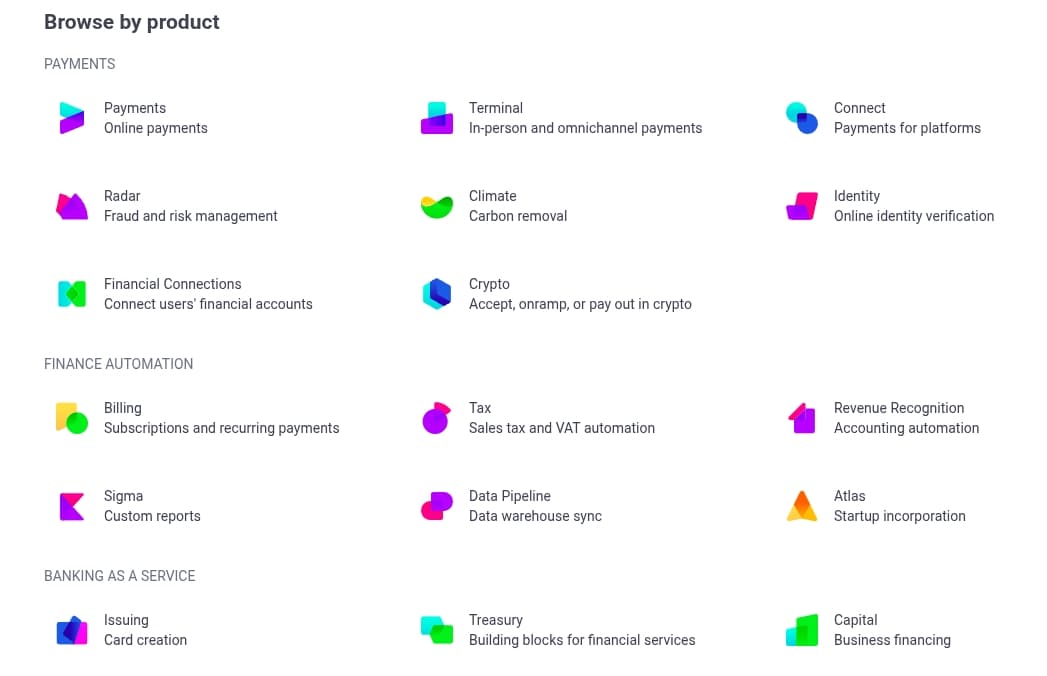
Source: Stripe
Function or API-based navigation
This approach organizes documentation around core functions, services, or APIs, regardless of which product they belong to. For example, grouping all authentication-related APIs together.
It is a great option for:
- When products share a backend or core services.
- When your audience is primarily developers who think in terms of tasks or endpoints.
- When modular features are reused across products or deployed in different configurations.
AWS documentation often uses function-based navigation (Compute, Storage, Networking), as many services are composable and users care more about functionality than product boundaries.
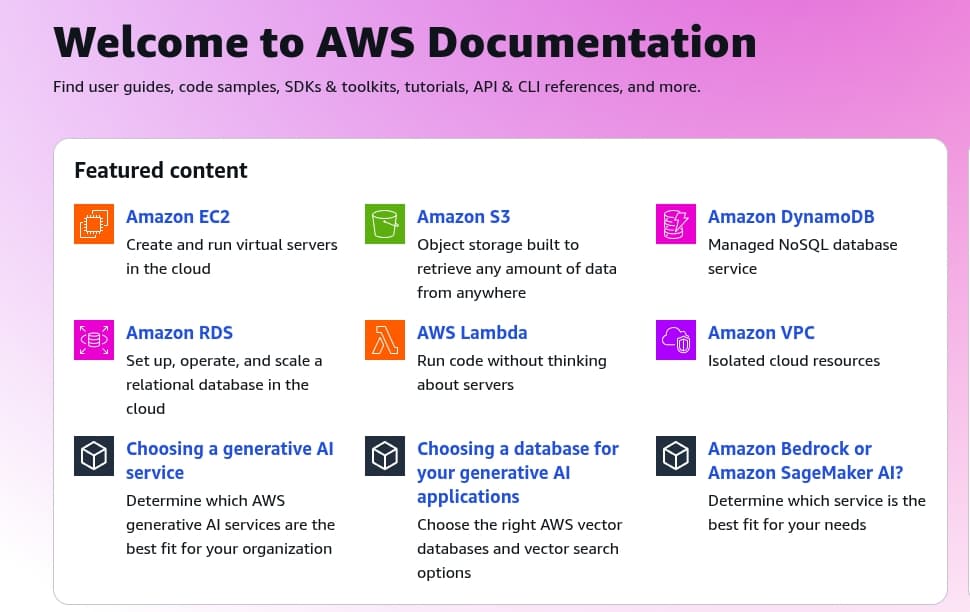
Source: AWS
Hybrid approaches
Many companies adopt hybrid models that mix both strategies:
- Primary navigation uses product-level hierarchy.
- Secondary navigation or filters offer views by functionality, API group, or use case.
Microsoft Azure’s documentation site allows users to navigate by product (Azure Functions, Azure Blob Storage) or use broader functional categories (Compute, Databases, DevOps).
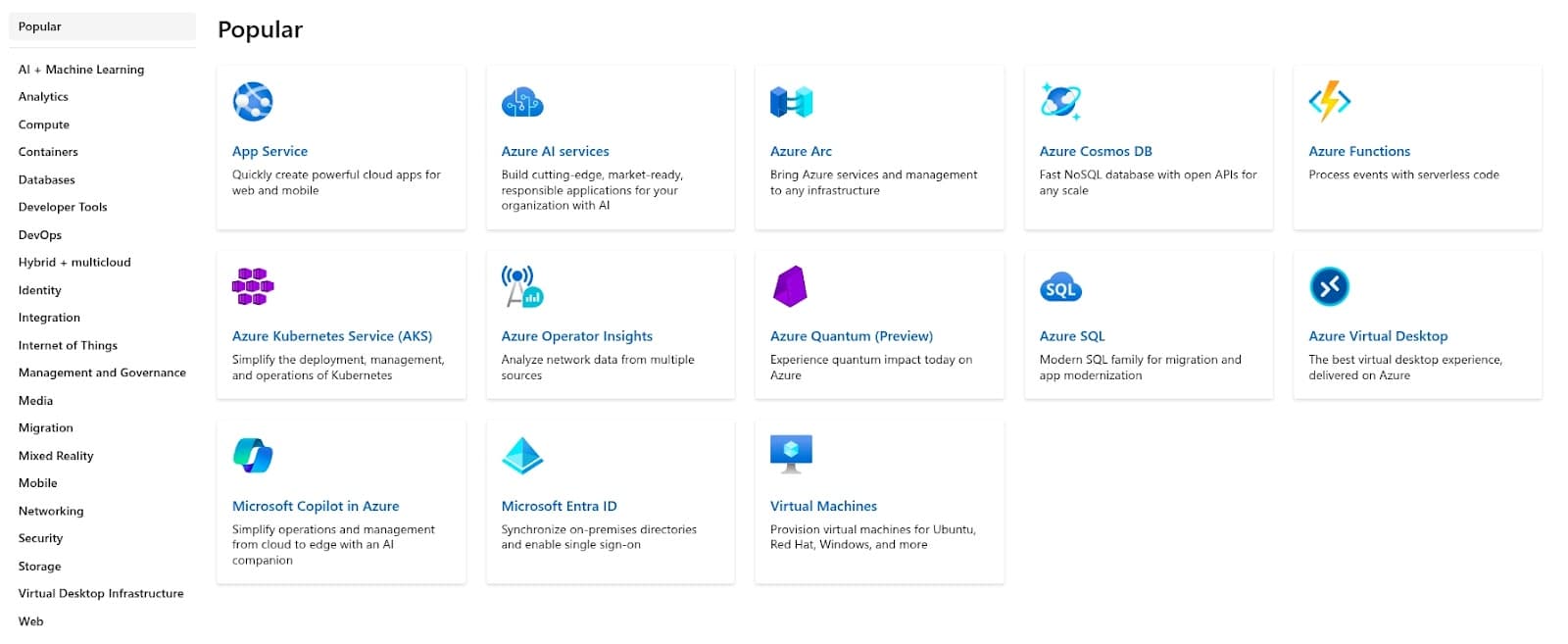
Source: Microsoft Azure
Consistency is key: Templates and structure
A shared information architecture and reusable documentation templates are critical in multi-product environments because they create consistency, efficiency, and scalability. Here's why they matter:
Consistency builds user trust
Imagine switching between two of your company’s products. In one, the API reference starts with “Endpoints”; in the other, you’re five clicks deep before you even find a URL.
But when every doc follows the same flow like “Overview → Authentication → Endpoints → Examples,” users know what to expect. It’s like giving them a map instead of dropping them in the wild with a compass and good luck.
Faster onboarding for new users
A shared structure means users don’t have to learn how to learn your product. They can jump straight into the good stuff.
Think: tutorials that always follow the “Goal → Steps → Code → Result → Troubleshooting” pattern. Whether it’s their first product or their fifth, users can skip the orientation and dive into solving problems faster.
Scalability for documentation teams
Templates are a writer’s best friend. Instead of reinventing the wheel for every new product doc, writers plug into consistent templates. That means faster production, no more headaches, and fewer “Wait, how did we structure this last time?” conversations.
Plus, it's much easier to get new contributors (or even engineers) to write good docs when they’re not starting from scratch.
Easier localization and translation
When content across products uses a clear structure, it simplifies translation workflows. Translators and localization platforms can rely on predictable formats. It cuts down on errors, speeds up turnaround times, and keeps your global users in the loop without driving your localization team to the brink.
Improved maintenance and updates
Need to update the privacy notice across different docs?
With a shared structure, you don’t have to search across dozens of different layouts. You can make bulk updates, knowing everything fits the same mold. This means less chaos, fewer missed edits, and happier legal teams.
The glue that holds it together: cross-linking in multi-product docs
Link it, don’t clone it. Referencing shared components, global concepts, and core services across multiple products calls for a modular, strategic approach, one that keeps things consistent without duplicating effort.
Reusable content modules
The most effective starting point is creating reusable content modules. These are standalone pieces of documentation (like pages on authentication, billing, error handling, or API versioning) that live in a central location, separate from individual product docs.
Instead of rewriting the same explanation a dozen times, writers can link to or embed these modules wherever needed. This ensures consistency, reduces maintenance, and spares everyone from manual copy-paste chaos.
Easy cross-linking
When shared content is too complex or broad to embed directly, clean cross-linking is your friend. Use clearly labeled, stable URLs so users can easily access deeper information without leaving a trail of broken links behind.
For instance, a product guide might simply say:
"This service uses our platform-wide OAuth 2.0 authentication. See the core authentication guide for setup instructions."
This keeps the documentation focused and task-oriented, while still offering paths to explore related concepts.
Implement a “global concepts” or "core services" section
Set up a centralized “Core Concepts” or “Platform Services” section. This is where shared topics, like identity management, rate limiting, usage tiers, or common infrastructure, can live in peace, with their own space and hierarchy.
Platforms like Stripe and Microsoft Azure do this well, grouping cross-product essentials in a high-level menu outside individual product silos.
Tag and label shared content for reuse
If your documentation tools support metadata, tagging shared content unlocks powerful reuse. A paragraph about webhook behavior, for example, might appear in five product docs but be maintained in just one location.
This dynamic reuse is especially handy in enterprise setups using DITA, Markdown-based static site generators, or CMS platforms with conditional content capabilities. The key: write once, reuse often.
One size doesn’t fit all: Tailor docs to your audience
Serving multiple reader types like developers, business customers, and internal teams is like designing an airport.
Everyone uses the same building, but they have very different needs. Developers are like pilots. They need detailed technical maps, air traffic protocols, and real-time system data, like API references, SDKs, and error codes.
Business users are more like passengers. They want a smooth experience, clear signs, and helpful staff, meaning setup guides, billing information, and feature overviews.
Internal teams are the ground crew. They need tools to keep everything running behind the scenes, from support workflows to monitoring tools.
Instead of building separate airports for each group, the smart approach is to design a unified space with clearly marked paths, shared infrastructure, and purpose-built zones. Great documentation works the same way. It keeps everything under one roof, while still guiding each audience to what they need without confusion or redundancy.
Tagging content by audience type
Just like airports mark zones for passengers, pilots, and staff, your docs should clearly label content by audience. Start by assigning metadata to each piece of content, like tagging a gate by destination and passenger class.
- audience: developer
- audience: customer
- audience: internal
- audience: admin
- audience: partner
Tagging enables your documentation platform to dynamically display or hide content based on the selected role. For instance, a page on billing might have two tagged callouts: one with code samples for developers, another with dashboard instructions for business users.
This approach is common in DITA, MDX, or CMS-driven systems where conditional rendering is supported.
Audience filters or role switchers in the UI
Let readers self-select their role when they arrive. Modern documentation platforms offer a role switcher or audience dropdown, just like passengers choosing baggage options or seating preferences.
For example:
- A developer sees API endpoints, code examples, and SDK instructions.
- A business user sees setup guides, product benefits, and compliance details.
- An internal user might see tools, troubleshooting playbooks, or staging environment notes.
Conditional content blocks
Use inline conditionals to vary content within the same page. It’s like adding signs in multiple languages or adjusting directions for pilots vs. passengers using the same corridor.
This allows you to maintain one source of truth while tailoring instructions or framing based on the audience.
Role-based access for internal or sensitive content
Not every door in the airport is open to the public. Some require a badge, others a boarding pass. Your documentation should follow the same logic. For internal teams, partner documentation, or regulated content (compliance notes), use authentication-based access controls. Public content is available to everyone. Partner-level content is gated via login. Internal docs are accessible only through the company SSO or VPN.
Platforms like Archbee and custom headless CMS solutions support granular access control by user role or team, making it easy to serve the right content to the right audience without managing multiple documentation portals. Archbee also allows you to manage both public and private knowledge bases in a single workspace, ideal for companies needing to support developers, customers, and internal staff from one place.
Structure your navigation and IA around audience journeys
Airports don’t just throw everyone into a big hall and hope they figure it out. They design signs and flows based on typical passenger needs: Arrivals, Departures, Customs, and so on.
Do the same for your documentation:
- Top-level nav items like “Developers,” “Business Users,” “Support Engineers”
- Or use journey-based categories like “Build,” “Manage,” “Troubleshoot,” which can apply across roles but host audience-specific guides inside.
This makes it easier for users to find their path and reduces the need for guesswork.
Staying in sync: Version control in multi-product environments
In environments where multiple products or APIs are evolving simultaneously, maintaining documentation alignment with each versioned release is essential to avoid user confusion, technical support overhead, and internal inconsistencies. A lack of structured version control often leads to outdated instructions, mismatched references, or API documentation that doesn’t reflect current behavior.
One of the foundational practices is to version your documentation just like your code. This means tagging releases, maintaining changelogs, and archiving older documentation so that users working with legacy versions can still access accurate references. Each major product or API release should trigger a corresponding documentation update cycle, ideally integrated into your CI/CD workflow.
For teams using web-based documentation platforms, Archbee offers built-in versioning capabilities that allow you to manage separate versions of your docs without maintaining multiple sites. You can easily spin up a new version when a product updates, retain access to previous versions for customers on older releases, and label content clearly with version identifiers.
Bringing it all together: Unified brand experience
In a multi-product company, delivering a unified brand experience through documentation is a bit like running a band. Every instrument has its own sound, but they all need to play in the same key. Otherwise, the audience gets noise instead of music.
Your docs should feel like they come from one brand, even if one product is aimed at developers deep in the command line and another is guiding business users through a dashboard. Striking that balance between consistency and flexibility is what keeps your documentation ecosystem both usable and reliable.
Establish a centralized style guide
Your style guide is your brand’s backstage pass. It defines your documentation’s tone, voice, and vocabulary. It serves as the baseline for all product documentation, ensuring that regardless of who is writing or what they’re writing about, the voice feels consistent.
For example, if your documentation voice is friendly, direct, and instructional, that tone should carry across every product, even if one product is deeply technical and another more customer-facing.
Allow flexibility through tone modulation
Voice should remain constant, but tone can vary subtly depending on the product’s audience or context. A developer-focused product may use more concise, technical phrasing and include more code blocks, while a non-technical business tool may use more explanations and UI-focused guidance.
Set guidelines for these tonal variations in your style guide, using examples. For instance:
- Product A (developer): tone is direct, minimal, and code-heavy.
- Product B (customer-facing): tone is helpful, slightly more explanatory, with UI walkthroughs.
This allows each product to “speak” to its audience without sounding like a different brand.
Cross-team reviews and editorial oversight
To keep everything in tune, give your central content team editorial authority. They’re not just proofreaders. They’re the ones making sure your docs sound like you, even when ten different teams are writing them.
Some companies even embed a content lead within each product team to support writing, while a central editorial group keeps the overall voice on track. This hybrid model scales well and avoids brand drift.
Maintain a shared terminology glossary
A centralized terminology list ensures that the same concepts are described in the same way across products. This helps avoid confusion and makes switching between product docs easier for users. It also helps enforce voice by avoiding redundant or inconsistent phrasing.
Use collaboration and component tools
In platforms like Archbee, teams can build and reuse shared components, such as alerts, notes, or standard intro paragraphs. These can be centrally updated, preserving brand tone while allowing each product team to control content at the topic level. Collaboration tools and approval workflows also make it easier to catch off-key content before it goes live.
From theory to practice: Real-world examples
Looking for inspiration? Here are a few multi-product companies that created comprehensive documentation for their tools.
Stripe: Developer-centric, product-modular docs
Stripe’s documentation is frequently cited as best-in-class for its clarity, consistency, and developer-first approach. Despite having multiple products (Payments, Billing, Connect, Terminal, Identity, etc.), Stripe maintains a consistent layout, writing style, and interaction pattern across all its documentation.
Why it works:
- Clean, minimal UI with excellent readability.
- Interactive API references with inline code generation.
- Clear product-level navigation combined with global concepts like authentication or versioning.
- Maintains a unified voice that’s approachable yet technical.
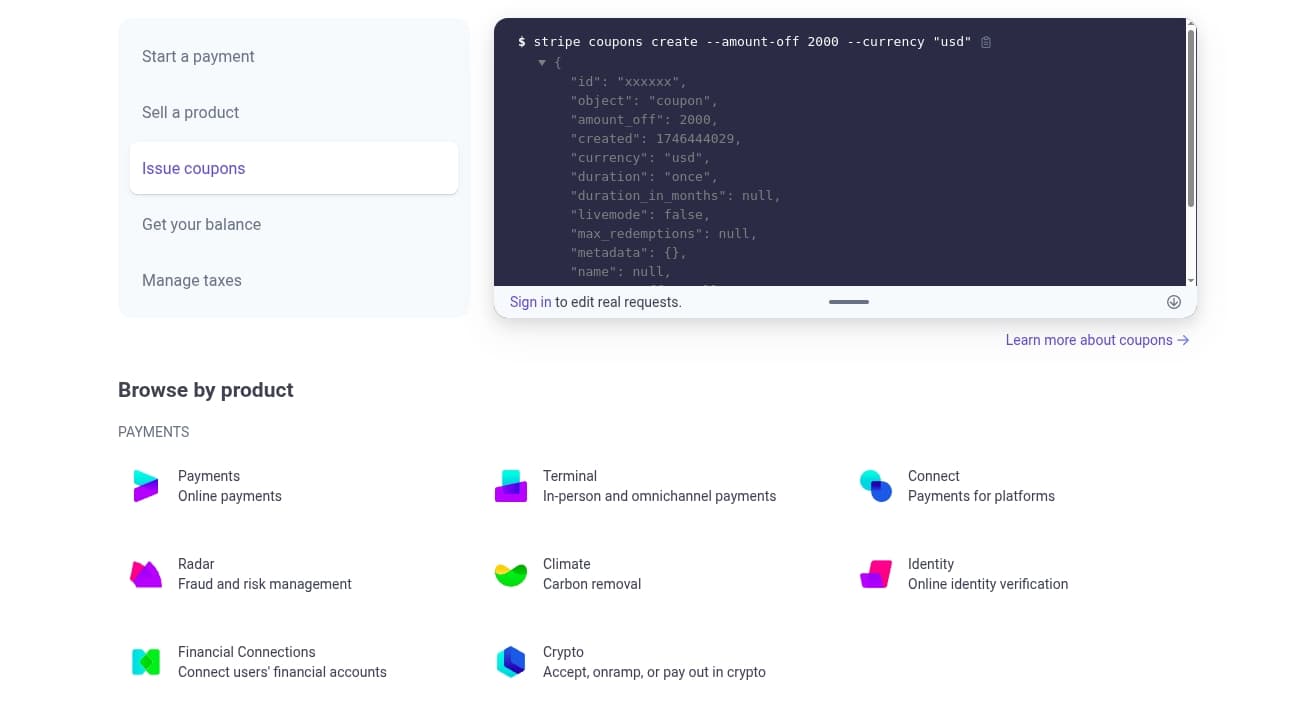
Source: Stripe
Shopify: Unified voice across APIs, themes, and admin docs
Shopify caters to merchants, app developers, and theme developers. Their documentation supports all of these users with tailored but cohesive resources.
Why it works:
- Separate sections for APIs, storefronts, and admin customization.
- Strong editorial consistency and brand voice.
- Clear product demarcation while sharing global standards like GraphQL usage, authentication, and testing.
- Rich use of diagrams and code walkthroughs.
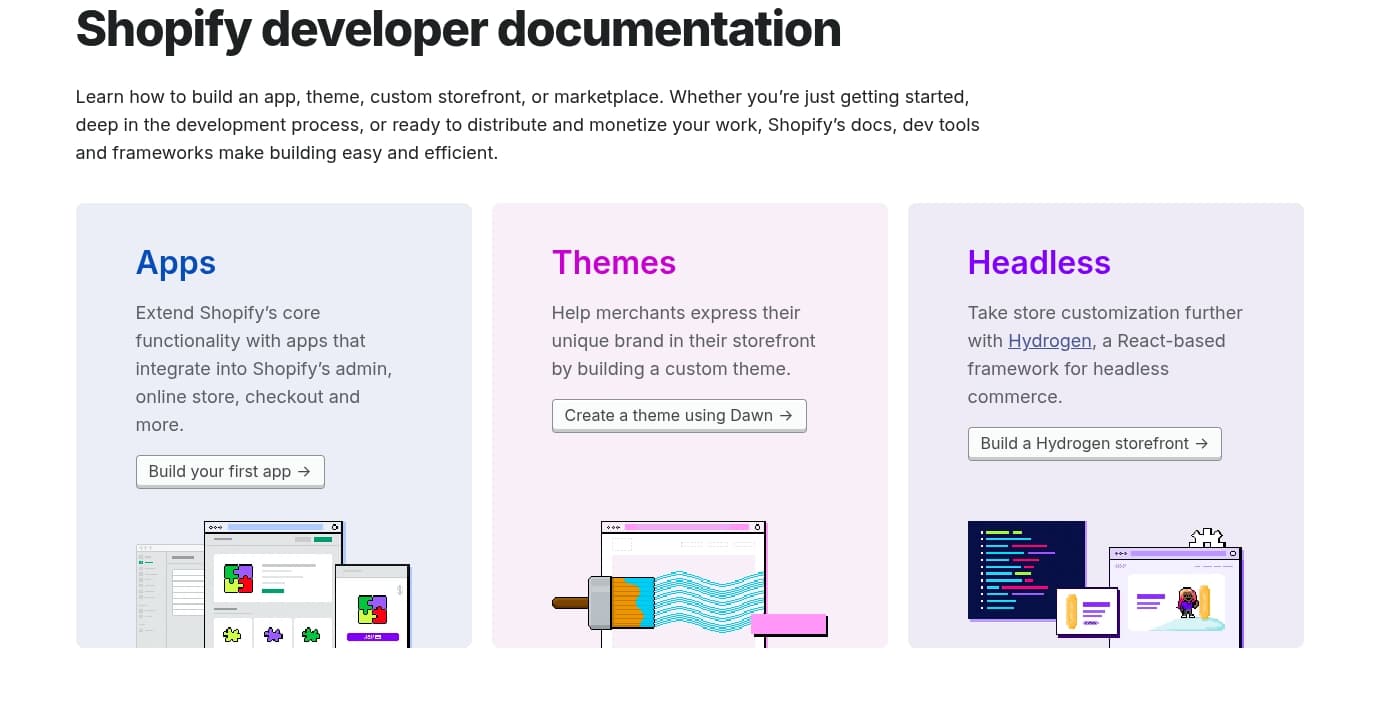
Source: Shopify
FISPAN: Modular banking documentation for ERP integrations
FISPAN provides embedded banking solutions that integrate directly into ERP systems like NetSuite and Intacct. Their platform connects financial institutions with business users by embedding services such as payments, reconciliation, and account visibility into existing ERP workflows.
Why it works:
- Product-specific documentation tailored to individual banking partners (e.g., CNB, Commerce Bank).
- Guides are modular and targeted, reducing complexity for users working within a specific ERP-bank pairing.
- Consistent structure across guides helps streamline onboarding for enterprise customers and partner banks.
FISPAN chose Archbee as their documentation platform because it “offered the flexibility and power we needed to create branded, high-quality, white-labeled documentation efficiently”.
Because of this, FISPAN managed to “balance content management costs and efficiency while also being able to present our customers' brand accordingly. We've seen this increased efficiency allow us to spend more time on the content itself, rather than spending time on re-branding documentation for our growing customer base.”
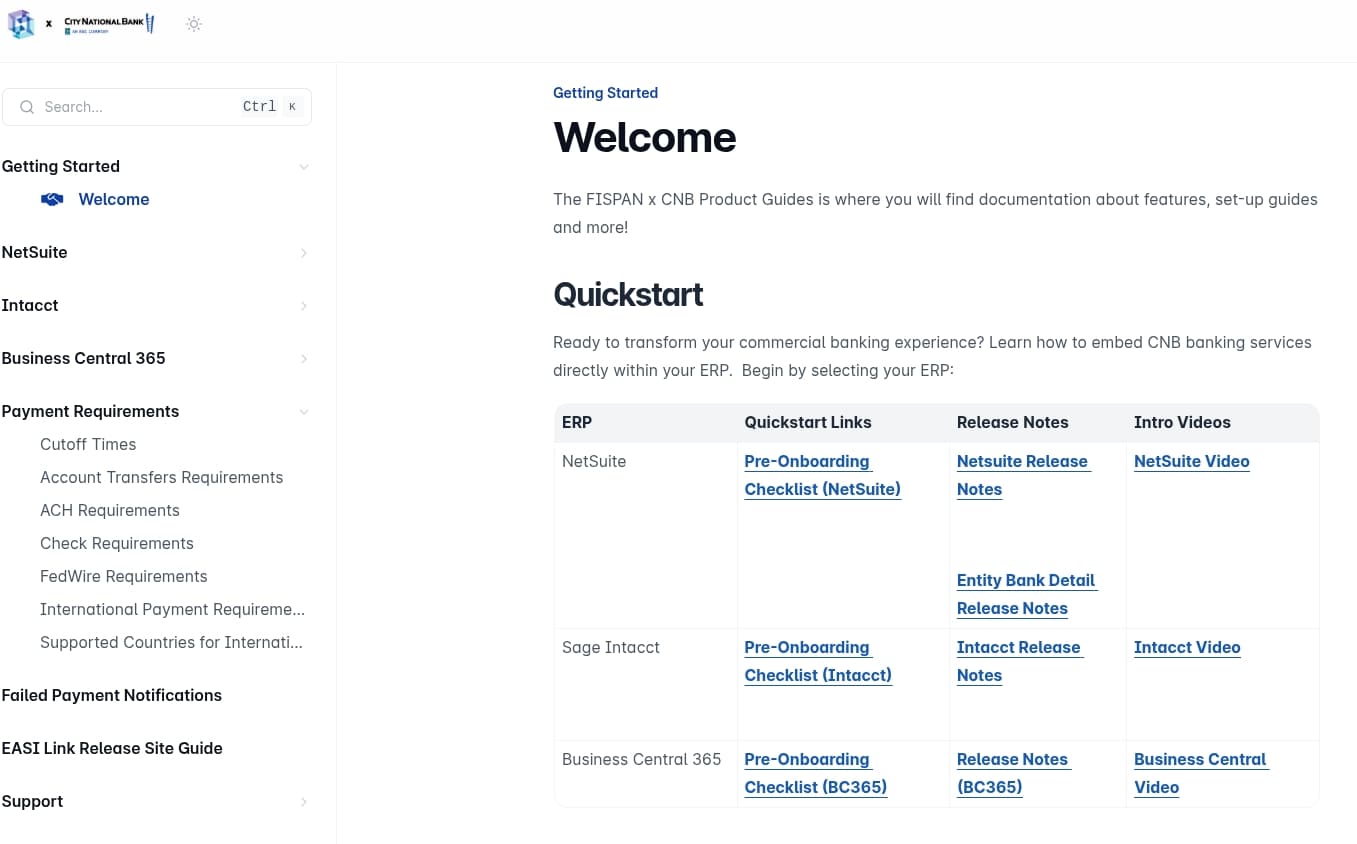
Source: FISPAN
Organizing the chaos, one doc at a time
Scaling documentation in a multi-product world isn’t just about keeping things tidy. It’s about building a system that grows with you. With the right mix of centralized structure, smart reuse, consistent voice, and role-aware navigation, your docs can stop being a bottleneck and start becoming a competitive advantage.
Because at the end of the day, great documentation it’s a product experience in itself. When done right, it builds trust, reduces friction, and turns complexity into clarity.
So plan smart, write clearly, and version like a pro. Your users will thank you.
Explore how Archbee can support your documentation strategy. Sign up for a free demo, and our team will assist you in building a robust, scalable documentation system tailored to your organization's multi-product needs.
Frequently Asked Questions
Adopt a hub-and-spoke model: centralize the standards, let product teams move fast, and add light governance to keep everything aligned. Do this in practice: - Standardize the foundation: create one style guide (voice, tone, grammar), a shared terminology glossary, and reusable templates for common page types (getting started, API reference, tutorials, release notes). - Centralize shared topics: build a Core Concepts area for cross-product content like auth, billing, errors, rate limits, and versioning. Link to it instead of duplicating. - Make navigation predictable: reuse the same IA patterns across products (overview, setup, build, manage, troubleshoot), add cross-links between related areas, and use consistent labels. - Add lightweight governance: assign page and section owners, set review and approval steps, and use checklists or linters for naming, structure, links, and terminology. - Automate the boring bits: use content snippets, variables for product names and URLs, shared notices/banners, bulk updates, and automatic broken-link checks. - Measure and improve: track search, usage, and support tickets; schedule audits; and feed insights into a docs backlog. This approach keeps the experience consistent while preserving team autonomy and speed.



